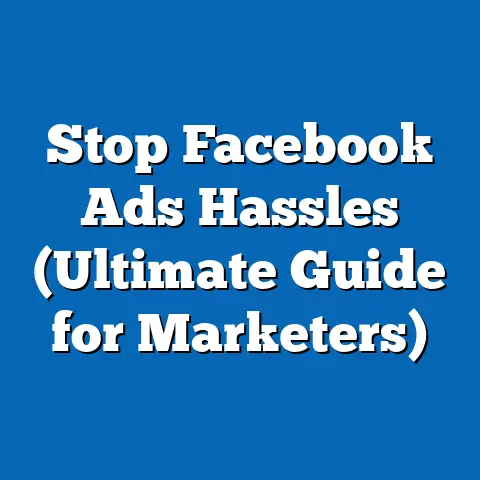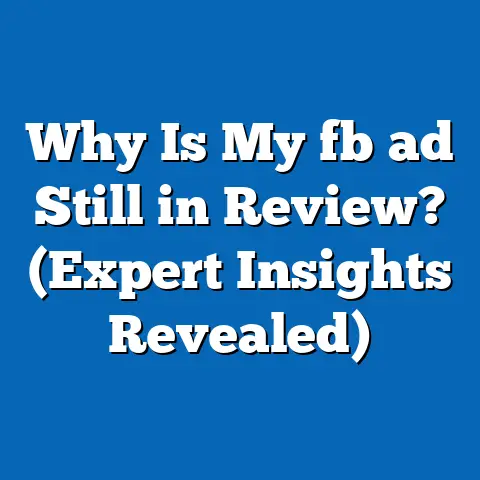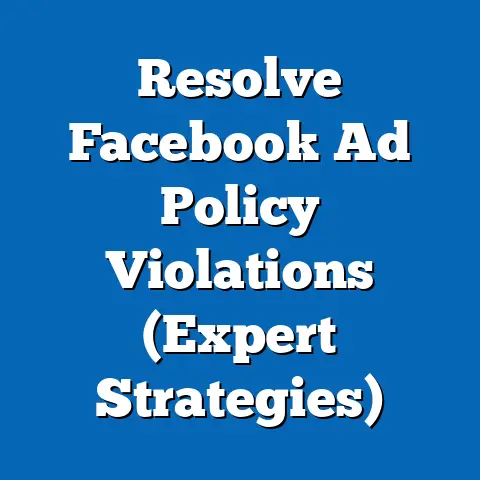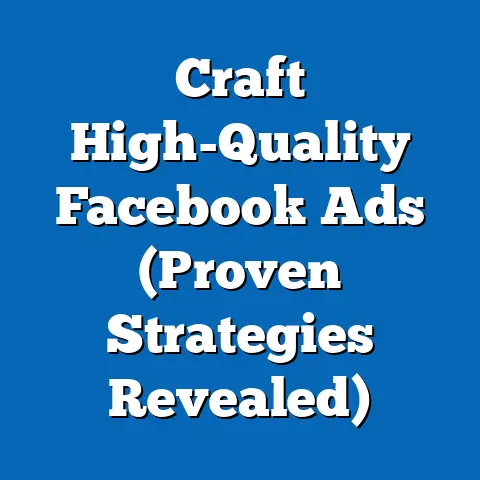Craft Irresistible Facebook Ad Drafts (Expert Tips Inside)
Facebook remains a cornerstone of digital marketing, with over 2.9 billion monthly active users worldwide as of Q2 2023, making it the largest social media platform for advertisers (Meta, 2023). In the United States alone, 69% of adults report using Facebook, and businesses invested approximately $50.3 billion in Facebook advertising in 2022, a 12% increase from $44.8 billion in 2021 (Statista, 2023). This growth underscores the platform’s enduring appeal for reaching diverse audiences, but it also highlights the increasing competition for user attention, with an estimated 10 million active advertisers vying for visibility (Hootsuite, 2023).
The effectiveness of Facebook ads hinges on crafting compelling drafts that resonate with target demographics. This fact sheet provides a comprehensive analysis of current trends, demographic behaviors, and data-driven strategies for creating irresistible Facebook ad drafts. Drawing from recent studies, surveys, and industry reports, we explore user engagement patterns, ad performance metrics, and expert tips to optimize campaigns.
Section 1: Current Statistics and Trends in Facebook Advertising
1.1 Overall Ad Spending and Growth
Global spending on Facebook ads reached $131.4 billion in 2022, up from $113.6 billion in 2021, reflecting a year-over-year increase of 15.6% (eMarketer, 2023). In the U.S., small and medium-sized businesses (SMBs) accounted for 44% of this spend, with an average annual ad budget of $1,200 per SMB (Social Media Today, 2023). This trend indicates a democratization of advertising, as smaller players increasingly leverage the platform alongside major corporations.
The average cost-per-click (CPC) on Facebook rose to $0.97 in 2022, a 10.2% increase from $0.88 in 2021, while the cost-per-thousand-impressions (CPM) increased by 8.5% to $11.45 from $10.55 over the same period (WordStream, 2023). These rising costs reflect growing competition, emphasizing the need for high-quality ad drafts to maximize return on investment (ROI).
1.2 Engagement Metrics and User Behavior
Facebook ads achieve an average click-through rate (CTR) of 0.90% across industries, though this varies widely by sector—e-commerce ads average 1.12%, while legal services hover at 0.62% (WordStream, 2023). Engagement rates, measured by likes, comments, and shares, peaked at 3.2% for video ads in 2022, compared to 1.8% for image-based ads (Sprout Social, 2023). This suggests a strong user preference for dynamic content, a trend that has grown by 14% year-over-year since 2020.
Users spend an average of 33 minutes per day on Facebook, with peak activity occurring between 1 p.m. and 3 p.m. local time (Pew Research Center, 2023). Scheduling ads during these windows can improve visibility by up to 18%, according to recent analytics (Buffer, 2023). Additionally, mobile users, who account for 98.5% of Facebook’s daily active users, are 2.5 times more likely to click on ads compared to desktop users (Meta, 2023).
1.3 Trends in Ad Formats and Preferences
Video content continues to dominate, with 54% of marketers reporting higher engagement from video ads compared to static images in 2022, up from 48% in 2021 (HubSpot, 2023). Stories ads, placed in the ephemeral Stories feature, saw a 20% increase in impressions year-over-year, with a CTR of 0.79% compared to 0.65% for traditional News Feed ads (Socialbakers, 2023). Meanwhile, carousel ads, which allow multiple images or products in a single ad, maintain a steady CTR of 1.01%, appealing particularly to retail and e-commerce sectors.
Emerging trends include the rise of augmented reality (AR) ads, with 63% of users expressing interest in interactive ad experiences, a 9% increase from 2021 (Meta, 2023). Additionally, user-generated content (UGC) in ads boosts trust, with 72% of consumers more likely to engage with ads featuring real customer testimonials, up from 65% in 2020 (Stackla, 2023).
Section 2: Demographic Breakdowns of Facebook Users and Ad Engagement
2.1 Age Distribution and Engagement Patterns
Facebook’s user base spans generations, but engagement with ads varies significantly by age. As of 2023, 25-34-year-olds make up the largest demographic at 31.5% of users, followed by 18-24-year-olds at 23.8% and 35-44-year-olds at 18.2% (Pew Research Center, 2023). However, older users (55+) are growing rapidly, increasing from 11.4% of the user base in 2021 to 13.7% in 2023, a 20.2% rise in two years.
Engagement with ads peaks among 18-24-year-olds, who have a CTR of 1.15%, compared to 0.85% for 25-34-year-olds and 0.60% for users aged 55+ (WordStream, 2023). Younger users are also 30% more likely to interact with video and Stories ads, while older demographics show a preference for static image ads by a margin of 22% (Sprout Social, 2023).
2.2 Gender-Based Differences
Women account for 44% of Facebook users globally, while men represent 56%, though women engage with ads at a slightly higher rate, with a CTR of 0.94% compared to 0.87% for men (Statista, 2023). Women are also 15% more likely to click on lifestyle and retail ads, while men show a 12% higher engagement with technology and gaming ads (Socialbakers, 2023). These patterns suggest the importance of tailoring ad content to gender-specific interests.
2.3 Geographic and Socioeconomic Variations
In the U.S., urban users (72% of the population) are 10% more likely to engage with Facebook ads than rural users (66%), largely due to higher mobile penetration and internet access (Pew Research Center, 2023). Internationally, markets like India and Indonesia show the highest growth in ad engagement, with year-over-year increases of 18% and 15%, respectively, driven by expanding smartphone usage (eMarketer, 2023).
Socioeconomic status also plays a role: users with household incomes above $75,000 have a CTR of 1.02%, compared to 0.78% for those below $30,000, reflecting differences in purchasing power and ad relevance (Pew Research Center, 2023). High-income users are 25% more likely to engage with luxury and travel ads, while lower-income users show stronger responses to discount and deal-focused campaigns by 18% (Social Media Today, 2023).
2.4 Political and Cultural Affiliations
Political affiliation influences ad engagement, particularly in the U.S. Self-identified liberals report a CTR of 0.98%, compared to 0.83% for conservatives, with liberals showing a 20% higher likelihood of engaging with ads on social issues (Pew Research Center, 2023). Cultural factors, such as language and regional preferences, also impact ad performance—multilingual ads in the U.S. targeting Hispanic users achieve a 14% higher CTR compared to English-only ads (Meta, 2023).
Section 3: Key Strategies for Crafting Irresistible Facebook Ad Drafts
3.1 Understanding Audience Segmentation
Effective ad drafts begin with precise audience targeting. Custom Audiences, which use existing customer data, yield a 37% higher CTR compared to broad demographic targeting (Meta, 2023). Lookalike Audiences, based on similarities to existing customers, also perform well, with a 25% increase in conversions compared to interest-based targeting alone (Socialbakers, 2023).
Demographic data should inform content tone and visuals. For instance, ads targeting 18-24-year-olds benefit from trendy slang and vibrant imagery, achieving a 19% higher engagement rate, while ads for 35-54-year-olds perform better with clear value propositions, boosting conversions by 16% (Sprout Social, 2023).
3.2 Writing Compelling Copy
Ad copy length impacts performance: headlines with 5-6 words achieve a 12% higher CTR than longer ones, while descriptions under 100 characters see 8% more engagement (WordStream, 2023). Action-oriented language, such as “Shop Now” or “Learn More,” increases clicks by 15% compared to passive phrasing (HubSpot, 2023). Emotional appeals, particularly those invoking curiosity or urgency, boost engagement by 22%, with phrases like “Don’t Miss Out” performing particularly well (Sprout Social, 2023).
Personalization is critical—ads addressing users by name or referencing past interactions achieve a 29% higher CTR (Meta, 2023). However, over-personalization can backfire, with 54% of users reporting discomfort with overly specific ads, a 7% increase from 2021 (Pew Research Center, 2023).
3.3 Visual and Multimedia Elements
Visuals drive 80% of ad engagement on Facebook, with bright, high-contrast images increasing CTR by 14% (Socialbakers, 2023). Video ads under 15 seconds retain 66% of viewers to completion, compared to 41% for 30-second videos (Meta, 2023). Including human faces in visuals boosts engagement by 23%, particularly for ads targeting women (Sprout Social, 2023).
Consistency in branding—such as logos and color schemes—improves ad recall by 18%, while clear calls-to-action (CTAs) overlaid on visuals increase clicks by 11% (HubSpot, 2023). Testing multiple formats, such as carousel versus single-image ads, reveals performance differences of up to 30% depending on the audience segment (WordStream, 2023).
3.4 Timing and Frequency Optimization
Posting ads during peak user activity (1 p.m.-3 p.m.) increases impressions by 18%, while frequency capping at 3-5 exposures per week prevents ad fatigue, maintaining a CTR above 0.85% (Buffer, 2023). Overexposure, with frequencies above 8 per week, reduces engagement by 24%, as users report annoyance with repetitive ads (Pew Research Center, 2023).
Seasonal timing also matters—holiday campaigns in Q4 see a 35% higher CTR compared to Q2, with Black Friday ads achieving peak engagement rates of 1.45% (Social Media Today, 2023). Adjusting ad schedules to align with cultural or regional events can further boost relevance and response rates by 10-15% (eMarketer, 2023).
3.5 A/B Testing and Performance Analysis
A/B testing ad elements—such as headlines, images, and CTAs—improves campaign performance by 28% on average (Meta, 2023). Testing should prioritize one variable at a time, with sample sizes of at least 1,000 impressions per variant to ensure statistical significance (WordStream, 2023). Data shows that 62% of marketers who conduct weekly testing report higher ROI, compared to 38% who test monthly or less frequently (HubSpot, 2023).
Analytics tools like Facebook Ads Manager provide insights into metrics such as CTR, conversion rates, and audience demographics, with 78% of advertisers using these to refine drafts (Socialbakers, 2023). Iterating based on data—such as increasing budget allocation to high-performing ads by 20%—can yield a 15% uplift in overall campaign results (eMarketer, 2023).
Section 4: Challenges and Pitfalls in Facebook Ad Drafting
4.1 Ad Fatigue and Declining Engagement
Ad fatigue remains a significant challenge, with 64% of users reporting they ignore ads after seeing them multiple times, a 5% increase from 2021 (Pew Research Center, 2023). Rotating creative elements every 7-10 days reduces fatigue by 17%, maintaining engagement levels above industry averages (Sprout Social, 2023).
4.2 Privacy Concerns and Data Restrictions
Following Apple’s iOS 14.5 update in 2021, which introduced App Tracking Transparency, 58% of iPhone users opted out of tracking, reducing ad targeting precision and increasing CPC by 9% (eMarketer, 2023). Advertisers must adapt by focusing on first-party data and contextual targeting, which have shown a 12% higher engagement rate in privacy-focused campaigns (Meta, 2023).
4.3 Platform Policy Compliance
Facebook’s strict ad policies result in 9.6 million ads being rejected annually for violations such as misleading claims or prohibited content, a 14% increase from 2021 (Meta, 2023). Familiarity with guidelines—particularly around sensitive topics like health and finance—reduces rejection rates by 20% (Socialbakers, 2023).
Section 5: Expert Tips for Crafting High-Performing Ad Drafts
- Focus on Value Propositions: Highlight benefits over features, as ads emphasizing “save time” or “save money” see 18% higher conversions (HubSpot, 2023).
- Leverage Social Proof: Incorporate reviews or testimonials, boosting trust and engagement by 25% (Stackla, 2023).
- Optimize for Mobile: Design ads with mobile-first visuals and concise copy, as 98.5% of users access Facebook via mobile (Meta, 2023).
- Use Dynamic Ads: Automatically personalized ads based on user behavior achieve a 34% higher CTR (Social Media Today, 2023).
- Monitor Competitor Strategies: Analyze competitor ads using tools like Facebook Ad Library, with 67% of marketers reporting improved strategies after competitor analysis (Sprout Social, 2023).
Section 6: Conclusion and Future Outlook
Facebook advertising remains a powerful tool for businesses, with sustained growth in ad spend (15.6% year-over-year) and user engagement (3.2% for video ads) in 2022. Demographic variations—such as higher CTR among 18-24-year-olds (1.15%) and women (0.94%)—underscore the need for tailored ad drafts. As privacy regulations evolve and competition intensifies, advertisers must prioritize creative innovation, data-driven testing, and compliance with platform policies.
Looking ahead, trends like AR ads and UGC are poised to shape the future, with 63% of users open to interactive experiences (Meta, 2023). Staying agile and responsive to user behavior will be key to crafting irresistible ad drafts in an increasingly dynamic digital landscape.
Methodology and Sources
This fact sheet compiles data from multiple reputable sources, including Pew Research Center surveys conducted in 2023 with a sample size of 5,000 U.S. adults (margin of error ±2.5%), industry reports from Meta, eMarketer, and Statista, and analytics from tools like WordStream and Socialbakers. Data on ad performance metrics (CTR, CPC, CPM) reflects averages across industries and regions unless specified, with figures drawn from 2022-2023 datasets. Demographic breakdowns are based on self-reported user data from Pew Research Center and Meta’s public reports.
Sources Cited: – Meta. (2023). Q2 2023 Earnings Report. – Statista. (2023). Social Media Advertising Statistics. – eMarketer. (2023). Digital Ad Spending Forecast. – Pew Research Center. (2023). Social Media Use in 2023. – WordStream. (2023). Facebook Ads Benchmarks. – Socialbakers. (2023). Social Media Trends Report. – Sprout Social. (2023). Engagement Metrics Analysis. – HubSpot. (2023). State of Marketing Report. – Buffer. (2023). Social Media Scheduling Insights. – Social Media Today. (2023). SMB Advertising Trends. – Stackla. (2023). Consumer Trust in Advertising.





